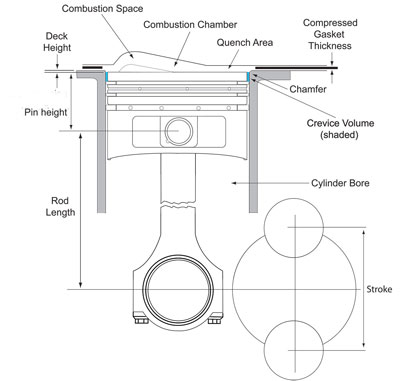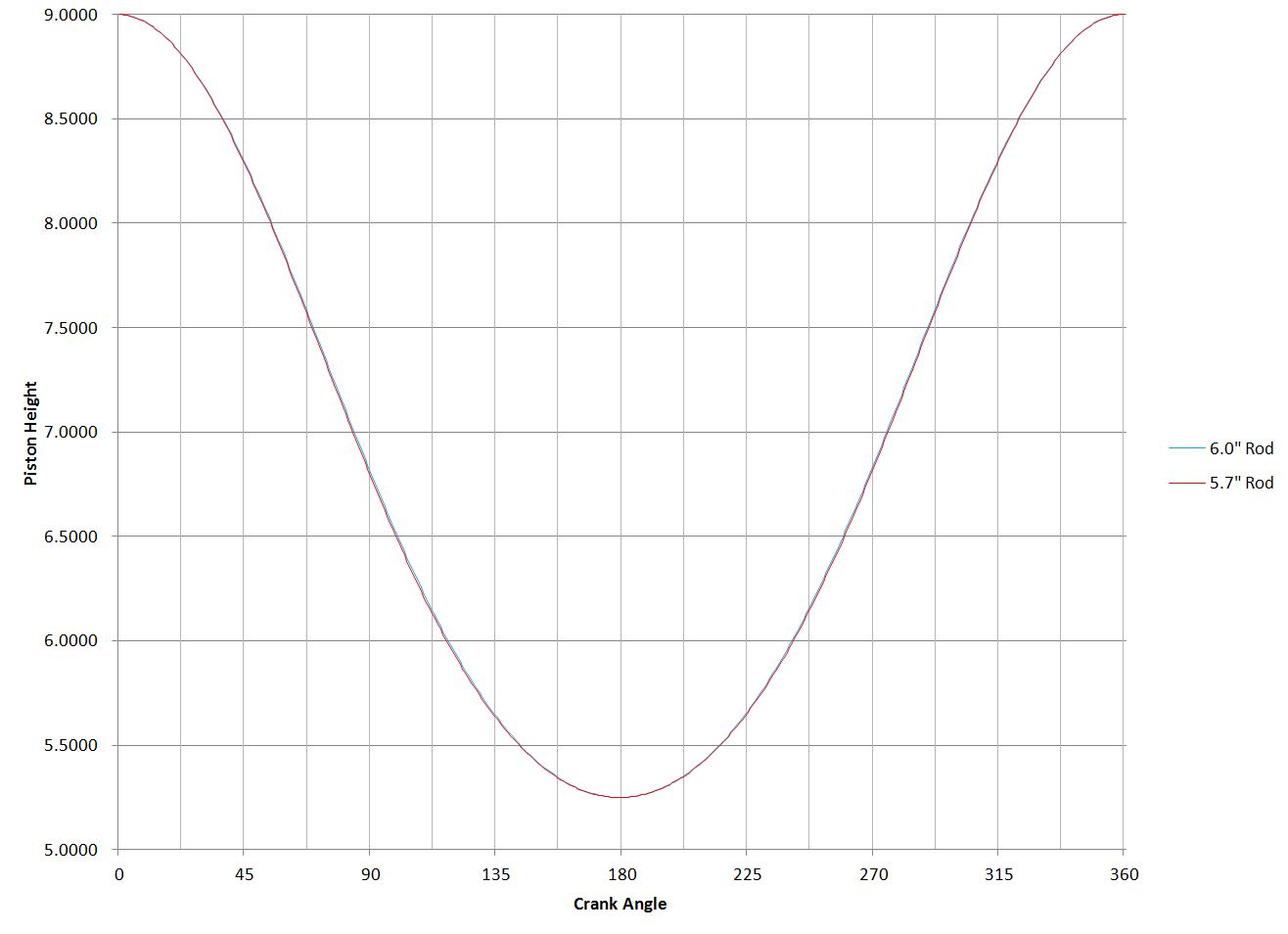8
87vette81big
Guest
Re: connecting rod info
:mrgreen:
:mrgreen:


65_Impala said:Since people can understand pictures so much better here is a graph of piston position vs crank angle for a full revolution of the crankshaft to compare the 5.7" rod and 6" rod.
link too bore vs stroke info on hundreds of engines
http://users.erols.com/srweiss/tablersn.htm

Big difference, right? :rotfl: Just for your reference the biggest difference is 0.0179".
Here's the rod angle.

At least this has a difference. A whole 1.026 degrees. An argument could be made that this would cause less wear on the bore. However, it occurs at the mid-way point of the stroke and I find that argument rather baseless unless someone can post up proof of an 5.7" rod 383 engine with the worst bore worn in the middle. The most wear occurs at the top of the bore where the rod angle is very little.
I really don't see where these ~huge~ changes between the 2 rods are going to make a hill of beans difference for a street going engine.
Now, if you wanted to wring every single possible HP out of the engine then maybe.
The ones making comments about how this makes such a huge difference in a street going application really need to post proof of the difference. Links to nice engine build aren't proving anything.



By David Reher said:“An engine produces peak torque at the rpm where it is most efficient.”
Recently I’ve had several conversations with racers who wanted to build engines with long crankshaft strokes and small cylinder bores. When I questioned them about their preference for long-stroke/small-bore engines, the common answer was that this combination makes more torque. Unfortunately that assertion doesn’t match up with my experience in building drag racing engines.
My subject is racing engines, not street motors, so I’m not concerned with torque at 2,000 rpm. In my view, if you are building an engine for maximum output at a specific displacement, such as a Comp eliminator motor, then the bores should be as big as possible and the stroke as short as possible. If you’re building an engine that’s not restricted in size, such as a heads-up Super eliminator or Quick 16 motor, then big bores are an absolute performance bargain.
I know that there are drag racers who are successful with small-bore/long-stroke engines. And I know that countless magazine articles have been written about “torque monster” motors. But before readers fire off angry e-mails to National DRAGSTER about Reher’s rantings on the back page, allow me to explain my observations on the bore vs. stroke debate.
In mechanical terms, the definition of torque is the force acting on an object that causes that object to rotate. In an internal combustion engine, the pressure produced by expanding gases acts through the pistons and connecting rods to push against the crankshaft, producing torque. The mechanical leverage is greatest at the point when the connecting rod is perpendicular to its respective crank throw; depending on the geometry of the crank, piston and rod, this typically occurs when the piston is about 80 degrees after top dead center (ATDC).
So if torque is what accelerates a race car, why don’t we use engines with 2-inch diameter cylinder bores and 6-inch long crankshaft strokes? Obviously there are other factors involved.
The first consideration is that the cylinder pressure produced by the expanding gases reaches its peak shortly after combustion begins, when the volume above the piston is still relatively small and the lever arm created by the piston, rod and crank pin is an acute angle of less than 90 degrees. Peak cylinder pressure occurs at approximately 30 degrees ATDC, and drops dramatically by the time that the rod has its maximum leverage against the crank arm. Consequently the mechanical torque advantage of a long stroke is significantly diminished by the reduced force that’s pushing against the piston when the leverage of a long crankshaft stroke is greatest.
An engine produces peak torque at the rpm where it is most efficient. Efficiency is the result of many factors, including airflow, combustion, and parasitic losses such as friction and windage. Comparing two engines with the same displacement, a long-stroke/small-bore combination is simply less efficient than a short-stroke/big-bore combination on several counts.
Big bores promote better breathing. If you compare cylinder head airflow on a small-bore test fixture and on a large-bore fixture, the bigger bore will almost invariably improve airflow due to less valve shrouding. If the goal is maximum performance, the larger bore diameter allows the installation of larger valves, which further improve power.
A short crankshaft stroke reduces parasitic losses. Ring drag is the major source of internal friction. With a shorter stroke, the pistons don’t travel as far with every revolution. The crankshaft assembly also rotates in a smaller arc so the windage is reduced. In a wet-sump engine, a shorter stroke also cuts down on oil pressure problems caused by windage and oil aeration.
The big-block Chevrolet V-8 is an example of an engine that responds positively to increases in bore diameter. The GM engineers who designed the big-block knew that its splayed valves needed room to breath; that’s why the factory machined notches in the tops of the cylinder bores on high-performance blocks. When Chevy went Can-Am racing back in the ’60s, special blocks were produced with 4.440-inch bores instead of the standard 4.250-inch diameter cylinders. There’s been a steady progression in bore diameters ever since. We’re now using 4.700-inch bores in NHRA Pro Stock, and even bigger bores in unrestricted engines.
Racers are no longer limited to production castings and the relatively small cylinder bore diameters that they dictated. Today’s aftermarket blocks are manufactured with better materials and thicker cylinder walls that make big-bore engines affordable and reliable. A sportsman drag racer can enjoy the benefits of big cylinder bores at no extra cost: a set of pistons for 4.500-inch, 4.600-inch or 4.625-inch cylinders cost virtually the same. For my money, the bigger bore is a bargain. The customer not only gets more cubic inches for the same price, but also gets better performance because the larger bores improve airflow. A big-bore engine delivers more bang for the buck.
Big bores aren’t just for big-blocks. Many aftermarket Chevy small-block V-8s now have siamesed cylinder walls that will easily accommodate 4.185-inch cylinder bores. There’s simply no reason to build a 383-cubic-inch small-block with a 4-inch bore block when you can have a 406 or 412-cubic-inch small-block for about the same money.
There are much more cost-effective ways to tailor an engine’s torque curve than to use a long stroke crank and small bore block. The intake manifold, cylinder head runner volume, and camshaft timing all have a much more significant impact on the torque curve than the stroke – and are much easier and less expensive to change.
I don't think it matters as much on the street .philly said:the science behind the big bore is universal, regardless of manufacturer... but i think your right the people with millions of hours and dollars invested dont want to give away ALL the findings for free.
87vette81big said:I don't think it matters as much on the street .philly said:the science behind the big bore is universal, regardless of manufacturer... but i think your right the people with millions of hours and dollars invested dont want to give away ALL the findings for free.
Big Bore.
Under square Long Stroke. Pontiac 455 Setup debunks that theory.
Pro stock N/A Yes. Have to turn 9,000-11,000 RPM To win.
The Big Critera is you can't beat that Hellcat N/A on an affordable plan in a 2-dr coupe car easy.
Only practical way is Supercharge or Turbo.
Do You Really Think Hellcat owners will leave it stock at 707 HP ?
I Know I would not.
Crankup boost to 1,000 HP.
So
I roll the Dice & Gamble at times Phil.philly said:why would i try to beat a supercharged v8 with an NA combo? i go turbo and whiz right by.
and you wait and see how hat car starts wetting the bed with any real power applied to it. no way that rear is gonna hold, or that stupid 8 speed tranny either. only time will tell.
87vette81big said:I roll the Dice & Gamble at times Phil.philly said:why would i try to beat a supercharged v8 with an NA combo? i go turbo and whiz right by.
and you wait and see how hat car starts wetting the bed with any real power applied to it. no way that rear is gonna hold, or that stupid 8 speed tranny either. only time will tell.
Hellcat will do serious damage to Vette scene & want to be racers hotrodders.
Shut Them all down...
And it will finally put You & me back to work.
No more Shit Fuck sidejobs.
No more managers taking the glory because they have more scratch than us.
Real Race knowledge & skills required to build .
Done with highly skilled 2 hands we have .
All pride shot rhey had prior.
You & me will be hired to build Better & Faster than the Hellcat.
You know I Especially like the 5.0 Fox Stang guys Phil.philly said:theres a dozen IRS vettes, zcars, and rx7's running 9.50 or faster in florida that i am aware of. so its possible... i just want to see how GM responds in the form of a ZR1 for the c7
at any rate... all this IRS talk is giving me a headache, you know theres a million fox bodies thatll give it to a hellcat on the street no problems, f bodies too. actually theres a guy down here in a naturally aspirated 4banger civic that runs better times than the hellcat and his car works on the street. so when the hellcat comes around we'll be ready. the technology is there, nothing is unbeatable.







